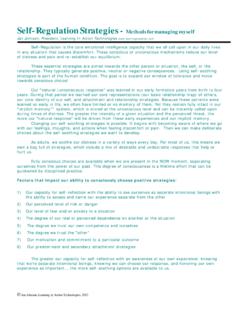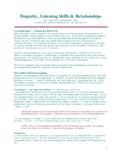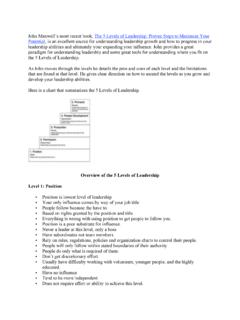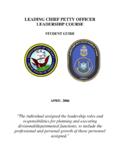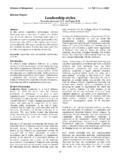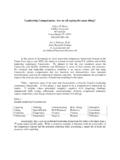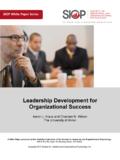Transcription of Leadership Lessons at Division Command Level - …
1 Leadership Lessons at Division Command Level - 2004. Walter F. Ulmer, Jr. Michael D. Shaler R. Craig Bullis Diane F. DiClemente T. Owen Jacobs A report prepared under the direction of the United States Army War College Carlisle Barracks, Pennsylvania 5 November 2004. [Please discard prior versions.]. Contents Study Team Members and Advisors iii Acknowledgments iv Section I: Executive Summary 1. ii Principal Study Team Members Walter F. Ulmer, Jr., LTG, Army (Retired). Michael D. Shaler, COL, Army (Retired). COL Steven A. Shambach, USAWC (February-June 2004). R. Craig Bullis, , USAWC (April-October 2004). Study Advisors COL George E. Reed, USAWC. David P. Campbell, Senior Fellow, Center for Creative Leadership Diane F. DiClemente, Visiting Professor of Psychology, USAWC. T. Owen Jacobs, Leo Chern Distinguished Visiting Professor, ICAF, National Defense University COL Thomas A.
2 Kolditz, Professor and Head, Department of Behavioral Science and Leadership , USMA. Gary E. Luck, GEN, Army (Retired) Senior Mentor, USJFC. Leonard Wong, Strategic Studies Institute, USAWC. iii Acknowledgments This study depended greatly on the candid, thoughtful, and enthusiastic participation of the Army officers from the four Divisions who had recently returned from a challenging tour of duty in Operation Iraqi Freedom. Their commitment to excellence and their mature professionalism reflected the essence of enduring Army values. Retired Senior Officer Contributors*. General John R. Galvin General Gary E. Luck General Edward C. Meyer General Dennis J. Reimer Lieutenant General Julius W. Becton, Jr. Lieutenant General Frederic J. Brown Lieutenant General Thomas N. Burnette, Jr.
3 Lieutenant General Randolph W. House Lieutenant General Dave R. Palmer Lieutenant General Dale A. Vesser Lieutenant General Robert L. Wetzel Lieutenant General John W. Woodmansee, Jr. Major General Thomas F. Cole Major General John C. Faith Major General Edwin P. Smith * These officers commented on instrument design, study methodology, or study issues. However, this acknowledgment of their generous assistance does not imply their support for any conclusions or recommendation of the study. iv SECTION I: EXECUTIVE SUMMARY. Background This study focuses on the development of Army leaders. The basic assumption is that good Leadership enhances both the short-term combat and related capabilities of the organization and the associated long-term health of the Army as an institution.
4 This study was authorized by the Commanding General, Army Training and Doctrine Command on 8 January 2004 and assigned to the Commandant, Army War College for execution. It was designed to take advantage of recent experiences within four Army Divisions just returned from 12-15. months of service in Operation Iraqi Freedom (OIF). With the variety of modes of combat and combat-related functions, restructuring of task forces, decentralization of tasks, interaction with governmental and non-governmental agencies, integration of Active and Reserve Component forces, and the inherent complexities of an often incoherent battlefield, OIF may be typical of future campaigns. The OIF environment highlighted two lingering challenges for organizational leaders. First, the need to attain immediate tactical success while maintaining the long-term health of the force.
5 Second, the need to establish the necessary centralized control to ensure integration of operating systems while encouraging and supporting the required initiative at subordinate levels . The data collection phase included surveys and interviews with 77 officers from four Divisions, plus two Corps Commanders and a Deputy Corps Commander, from March through October 2004. This field work was supported by the Commanding Generals of Army FORCES Command , Army Europe, and the Commanding Generals of III, V, and XVIII Corps, along with the full cooperation of the Commanding Generals of the Divisions involved in the study. Study goal and focus The goal of the study was to contribute to future operational readiness and institutional strength of the Army by providing insights and recommendations regarding Leadership at Division Level .
6 The study was designed also to be useful in other areas of officer training, education, selection, and development by identifying those behaviors that are crucial for contemporary leader effectiveness, and by suggesting methods for inculcating those behaviors. The study focused on Division Commanders. They continue to play major tactical and operational roles. In the complex 21st Century environment such as OIF, their actions often have immediate strategic impact as well. Even on a complex, dispersed battlefield their personal Leadership style has substantial impact on the quality of the Command climate and the resulting capability for sustained operational effectiveness. Occupying prominent traditional positions within the Army structure, they represent collectively the primary pool for future three and four-star leaders from the Combat and Combat Support arms.
7 Study assumptions The officers who participated in the study, the Commanders, Assistant Division Commanders, Chiefs of Staff, eight members of each Division Staff, and from six to ten subordinate commanders in each Division , were assumed to be familiar with Army Leadership doctrine and had formed opinions regarding the behaviors of good and poor leaders whom they had personally observed. This assumption proved to be correct. It was also assumed that these Divisions were generally healthy organizations that had performed well in OIF. That assumption, validated both inside and outside the Divisions, was also correct. Another assumption was that Army transformation, with new organizational structures, would still require competence in tactical, technical, conceptual, and interpersonal Leadership skills, understanding that the appropriate mix and type of skills would continue to evolve.
8 There were no data from which to conclude that these four Divisions are typical of other Army Divisions. A reasonable but unsupportable assumption is that they are. Leadership doctrine and study methods Current Army Leadership doctrine is outlined in AR 600-20, Army Command Policy, and FM 22- 100, Army Leadership . Required skills are discussed in four areas: tactical, technical, interpersonal, and conceptual. A number of Army pamphlets and studies have provided additional input in describing what particular capabilities senior or strategic leaders should have. Army values, expressed in FM 22- 100 and elsewhere, set the foundation for how officers function as dedicated professionals. The study aimed at observable behaviors not inherent competencies or traits but on actions that officers take to direct and motivate others and to create Command climates that support sustained operational excellence.
9 By identifying specifically which leader behaviors are responsible for perceptions of good and poor Leadership , there would be a basis for conclusions and recommendations regarding contemporary Army leader development systems. The study relied on interview data (averaging 2-3 hours per participant) as well as on the quantitative results from the survey instruments. The statistical data and the interviews were mutually supporting, and the results unambiguous. Study Participants DIV DIV SUBORD. CORPS. GRADE TOTAL. HQ STAFF CMDR HQ. O-9 0 0 0 2 2. O-8 4 0 0 1 5. O-7/6P 6 0 0 0 6. O-6 3 1 18 0 22. O-5 0 16 14 0 30. O-4 0 11 0 0 11. O-3 0 4 0 0 4. TOTAL 13 32 32 3 80. Selected summary data The Leader Behavior Preference Worksheet (LBP). Chart 1 shows selected data from the Leader Behavior Preference (LBP) instrument, designed specifically for this study.
10 After reviewing Army Leadership doctrine and prior Leadership studies, consulting with active duty and retired officers, and holding discussions with Army War College students and faculty members, a list of 29 important, positive behaviors was developed as an instrument to collect written anonymous survey data and to stimulate discussions about Leadership . These behaviors that distilled Army Leadership doctrine and reflected continuing concerns of the Army officer corps were those particularly critical in creating a Command climate that supports operational excellence and also motivates competent people to continue military service. Participants were required to select a particular number of items in four categories as shown. Each selection was independent and followed by a discussion.

